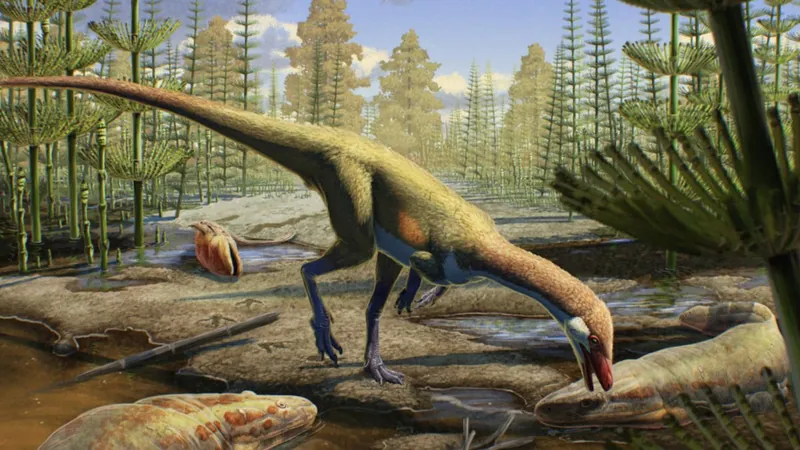
Uncovering the Ancient: The Discoveries of North America's Oldest Dinosaur Could Redefine Your Understanding of Prehistoric Life!
2025-01-10
Author: Ming
Groundbreaking Discovery
In a groundbreaking discovery, scientists have unearthed the oldest dinosaur ever found in North America, dating back an astonishing 230 million years. This newly identified species, a previously unknown raptor named *Ahvaytum bahndooiveche*, has not only shocked paleontologists with its age but also challenged long-standing beliefs about the emergence and spread of dinosaurs across the Earth.
The Size and Significance of *A. bahndooiveche***
About the size of a chicken, *A. bahndooiveche* is believed to be a distant ancestor to the colossal sauropods that roamed the Earth millions of years later, including dinosaurs like Brachiosaurus and Diplodocus. This remarkable finding was initiated in 2012 when partial remains from multiple individuals were discovered at the Popo Agie Formation in Wyoming, consisting mainly of leg bones that date back to the Triassic period, which spanned from approximately 251.9 to 201.3 million years ago. The name *Ahvaytum bahndooiveche* translates to 'long ago dinosaur' in Eastern Shoshone, reflecting the cultural heritage of the local Indigenous people whose lands house these ancient fossils.
Research Findings
According to David Lovelace, the lead author of a recent study published on January 8 in the *Zoological Journal of the Linnean Society*, the findings indicate that *A. bahndooiveche* was likely fully grown at about a foot (0.3 m) tall and three feet (0.9 m) long. Lovelace remarked, 'It was basically the size of a chicken but with a really long tail,' suggesting a form and posture that differentiates it from the massive giants we often associate with the dinosaur era.
Implications for Dinosaur Migration Patterns
The research holds significant implications for dinosaurs' migration patterns. Until now, scientists believed it took dinosaurs about 10 million years to make their way from Gondwana, the southern part of the supercontinent Pangea, to Laurasia, the Northern Hemisphere region that comprises modern-day North America and parts of Europe and Asia. However, the new findings reveal that *A. bahndooiveche* is only about 3 million years younger than the oldest recognized dinosaur from Gondwana, an unnamed species of Herrerasaurid discovered in Brazil.
Potential Footprints and Climate Influence
In addition to the fossils, the research team has identified potential dinosaur footprints in the vicinity that may even predate the discovered fossils. Still, additional research is needed to confirm their significance.
Revising the Timeline of Dinosaur Evolution
The early emergence of dinosaurs in Laurasia could have been influenced by the Carnian Pluvial Episode, a climatic phenomenon that occurred around 234 to 232 million years ago, providing a wetter environment that could have helped early dinosaurs traverse dry regions around the equator. As researchers continue to explore these findings, it becomes clear that the timeline of dinosaur evolution could be significantly revised.
Conclusion
This evidence shows that our previous assumptions about the timing and spread of dinosaurs in the Northern Hemisphere were not entirely accurate,' said Lovelace. The revelations from this discovery are prompting scientists to reevaluate their understanding of early dinosaur evolution and migration, potentially rewriting the history of these fascinating creatures.
Future Discoveries Await
As paleontologists dive deeper into this intriguing chapter of Earth's history, the anticipation builds. What more secrets might the past reveal about these colossal beings? Stay tuned for more shocking revelations from the world of prehistoric research!

 Brasil (PT)
Brasil (PT)
 Canada (EN)
Canada (EN)
 Chile (ES)
Chile (ES)
 Česko (CS)
Česko (CS)
 대한민국 (KO)
대한민국 (KO)
 España (ES)
España (ES)
 France (FR)
France (FR)
 Hong Kong (EN)
Hong Kong (EN)
 Italia (IT)
Italia (IT)
 日本 (JA)
日本 (JA)
 Magyarország (HU)
Magyarország (HU)
 Norge (NO)
Norge (NO)
 Polska (PL)
Polska (PL)
 Schweiz (DE)
Schweiz (DE)
 Singapore (EN)
Singapore (EN)
 Sverige (SV)
Sverige (SV)
 Suomi (FI)
Suomi (FI)
 Türkiye (TR)
Türkiye (TR)
 الإمارات العربية المتحدة (AR)
الإمارات العربية المتحدة (AR)